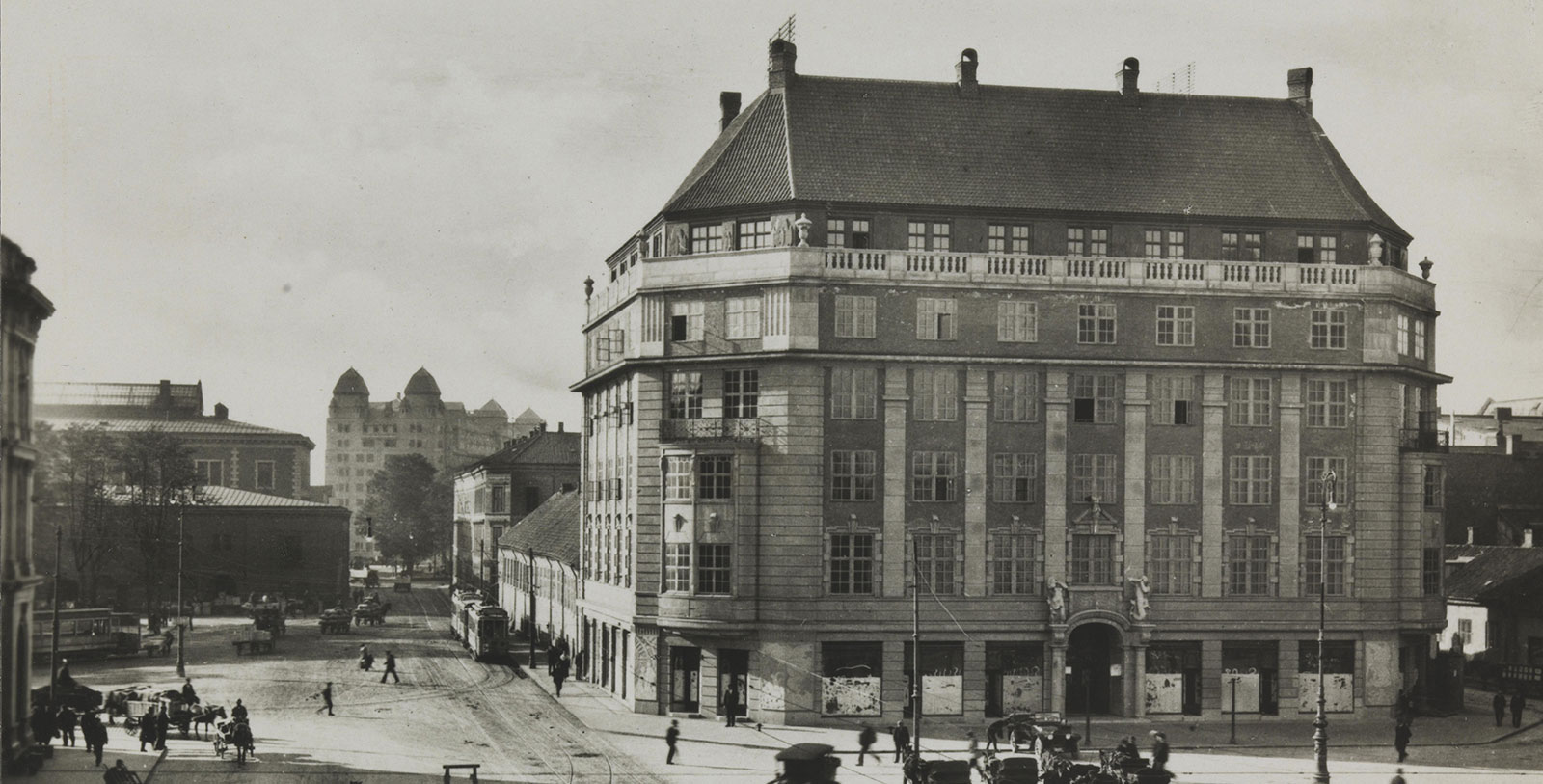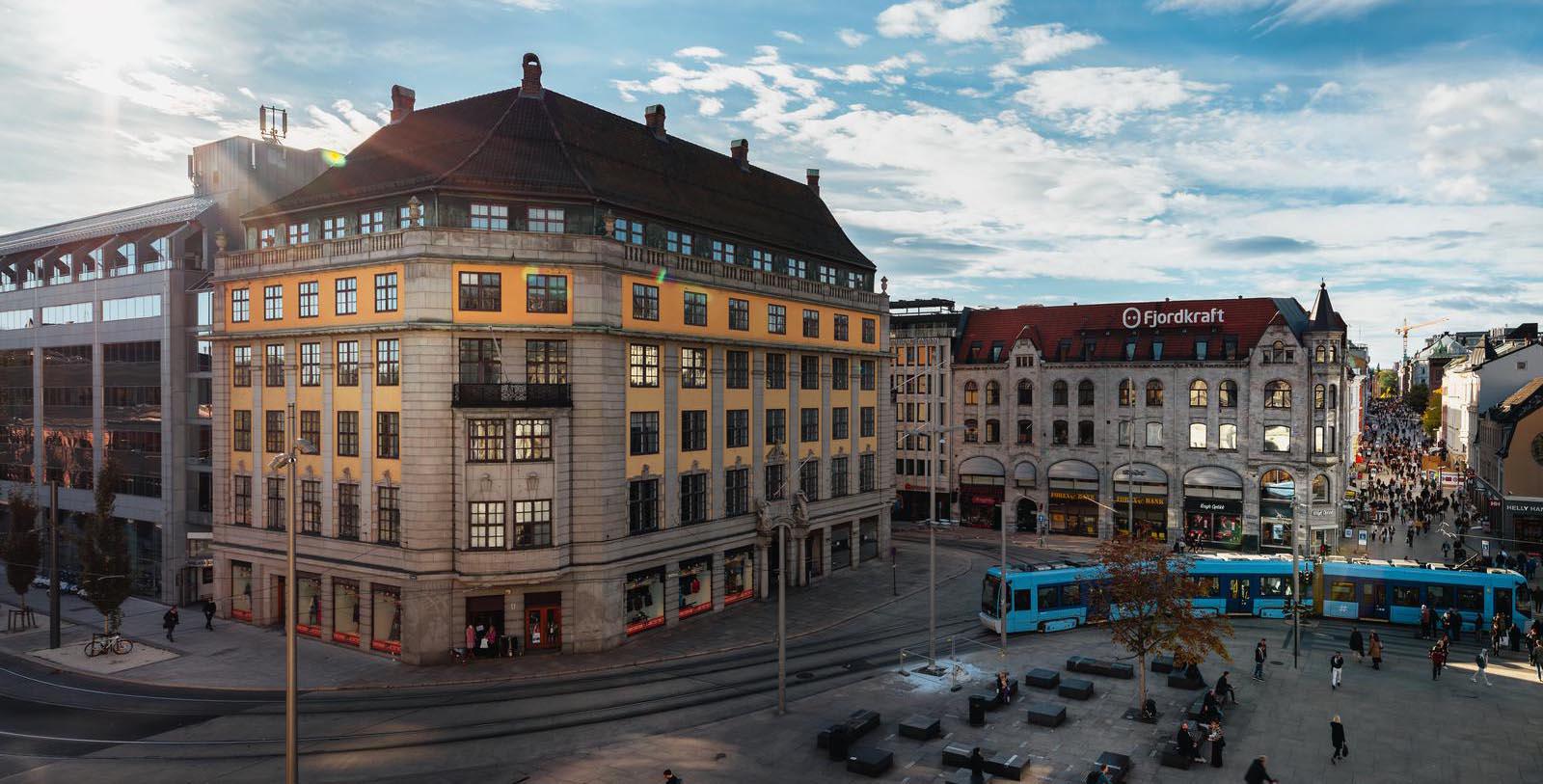Receive for Free - Discover & Explore eNewsletter monthly with advance notice of special offers, packages, and insider savings from 10% - 30% off Best Available Rates at selected hotels.
history
Discover the heritage of the Amerikalinjen, which was once the headquarters for the historic Norwegian American Line.
Amerikalinjen: Then & Now
Discover the history of the historic Den Norske Amerikalinje company at Amerikalinjen. Open since 2019, this fantastic historic building has stood as an icon in downtown Oslo for more than a century.
WATCH NOWA member of Historic Hotels Worldwide since 2019, Amerikalinjen was constructed during an era marked by global industrialization following World War I. The specific history of the Amerikalinjen dates back to the early 20th century, when the building served as the headquarters for the Den Norske Amerikalinje (Norwegian American Line). Founded in 1910, the Den Norske Amerikalinje operated as both a cruise line and a freight company that transported mail, cargo, and people from Norway to America. The business continued to grow and by the end of World War I, Den Norske Amerikalinje became one of Norway’s largest shipping companies, with an active fleet of 19 ships. Driving this growth, was a surge in immigration to the United States, specifically New York City. Thousands of Norwegians passed through the port of Oslo to find new opportunities in America. As such, Den Norske Amerikalinje ferried countless Norwegians across the ocean during much of the early 1900s. The company soon began looking for a location in the heart of Oslo to build a central headquarters from which it could manage its burgeoning maritime enterprise. Den Norske Amerikalinje then selected a site near the city’s harbor, developing a beautiful, multi-storied building at the spot shortly thereafter. By 1919, the building, named the Amerikalinjen, was complete. Den Norske Amerikalinje ran its fleet from the Amerikalinjen for the next several decades, gradually transitioning away from transporting people to exclusively carrying cargo. However, competition from other modes of transportation slowly took over Den Norske Amerikalinje’s market, causing the company to go under in 1995. Amerikalinjen is now a prominent boutique hotel nestled along Oslo’s majestic shoreline. Over the last few years, the building underwent an extensive series of renovations that breathed new life into the historic structure. The ambitious Scandinavian Design Group oversaw the building’s refurbishment, using letters written by the Norwegian immigrants who passed through the Amerikalinjen as the inspiration for their work. The design firm captured the feeling of fluidity and adventure as it reconstructed the Amerikalinjen’s marvelous, historical interior for a modern audience.
-
About the Location +
Norway’s capital city, Oslo is a community stepped in history. Its founding dates back nearly a thousand years, with many records dating its creation to the reign of the legendary Viking king Harald Hardrada. The earliest known residents had established the city on the east side of the Bjørvika inlet, just below the Ekeberg hills. They specifically hoped to use the nearby natural harbor to attract maritime traders. Oslo remained a small coastal community for many centuries thereafter, until King Haakon V of Norway made it his royal seat at the start of the 14th century. Despite occupying the throne for only a brief period (1299 – 1319), the king nonetheless managed to greatly expand the city’s borders. Indeed, King Haakon V oversaw the creation of many outstanding building projects, including the imposing Akershus Fortress and a sprawling royal residence remembered as the “Kongsgård.” (Only ruins of its foundation remain today.) Oslo subsequently remained the official royal capital for many years thereafter, emerging as the main cultural hub in the entire kingdom. But in 1397, Queen Margrethe I of Denmark married a Norwegian king named Hakon Magnusson. Their marriage unified all of Scandinavia together into one fiefdom dominated by Danes. Her chosen successor, Eric of Pomerania, then selected the Danish city of Copenhagen as the new royal capital. Under Norway’s new personal union with Denmark, Oslo was reduced to just an administrative center for the communities situated all over the eastern part of the country.
Oslo also experienced a number of hardships following the marriage, including several destructive fires that occurred periodically over the course of the European Renaissance. In fact, the last inferno—which occurred in 1624—was so calamitous that it inspired King Christian IV of Denmark to consider rebuilding the entire metropolis at a new location. After reviewing several potential building spots, the king ultimately commanded a contingent of royal engineers to start redeveloping Oslo on the other side of the bay. Renaming the settlement as “Christiana,” the city quickly flourished as a prominent economic seaport off of the North Sea. Many in Europe also hailed King Christian’s construction project to be architecturally magnificent, for all the new neighborhoods featured an awe-inspiring octagonal layout. (Many locals had informally called the area the “Kvadraturen,” which was a direct attribution to its unique street grid.) The more historic sections of Oslo endured as a separate entity, where it remained underdeveloped compared to its neighbor. Christiana remained a prosperous metropolis for some time thereafter, especially once most of the continental superpowers went to war with one another in the 18th century. Those armed confrontations resulted in the city becoming a major bastion for shipbuilding, in which its residents' created vessels for dozens of nations like Great Britain and the Netherlands. But the most manufacturing transpired during a long conflict known as the Great Northern War, when local shipwrights specifically produced boats on Denmark’s behalf.
Christiana returned to political importance following the Napoleonic Wars, when the city once again became the capital on a newly formed Kingdom of Norway. The country managed to function as a separate kingdom, despite being governed nominally by the Swedish king, Karl Johan, through another personal union. The king subsequently presided over another period of rapid economic growth in Christiana, as many new beautiful municipal structures made their debut. While dozens of gorgeous structures opened at the time—including the Bank of Norway and the Storting—the most illustrious was the magnificent Royal Palace. Industrialization began to spread throughout the city around the same time, which further solidified Christiana’s place as one of Europe’s leading communities. In fact, its economic prosperity attracted thousands of immigrants from across the continent. So many people had moved into the area that Christiana eventually absorbed several surrounding settlements—including the earlier Oslo—as a way to better administrate the the burgeoning population. Then, in 1905, Norway’s personal union with Sweden came to an end. In its wake, the kingdom emerged as a truly sovereign state, with Christiana—then called “Kristiana”—remaining as its capital. To reassert a sense of national identity, the new Norwegian government decided to rename Kristiana as “Oslo” in honor of the city’s heritage. Today, Oslo continues to be among Europe’s most vibrant communities. Truly few other places can rival this amazing city in both history and prestige than Oslo.
-
About the Architecture +
Amerikalinjen reflects a gorgeous blend of Neoclassical design elements. Also known as “Neoclassical,” Classic Revival architecture itself is among the most common architectural forms seen throughout the world today. This wonderful architectural style first became popular in Paris, specifically among French architectural students that studied in Rome in the late 18th century. Upon their return, the architects began emulating aspects of earlier Baroque design aesthetics into their designs, before finally settling on Greco-Roman examples. Over time, the embrace of Greco-Roman themes spread across the world, reaching destinations like Germany, Spain, and Great Britain. As with the equally popular Revivalist styles of the same period, Classical Revival architect found an audience for its more formal nature. It specifically relied on stylistic design elements that incorporated such structural components, like the symmetrical placement of doors and windows, as well as a front porch crowned with a classical pediment. Architects would also install a rounded front portico that possessed a balustraded flat roof. Pilasters and other sculptured ornamentations proliferated throughout the façade of the building, too. Perhaps the most striking feature of buildings designed with Classical Revival-style architecture were massive columns that displayed some combination of Corinthian, Doric, or Ionic capitals. With its Greco-Roman temple-like form, Classical Revival-style architecture was considered most appropriate for municipal buildings like courthouses, libraries, and schools. Architects still rely on Classic Revival architecture when designing new buildings or renovating historic ones, making it among the most ubiquitous architectural styles in the world.




























